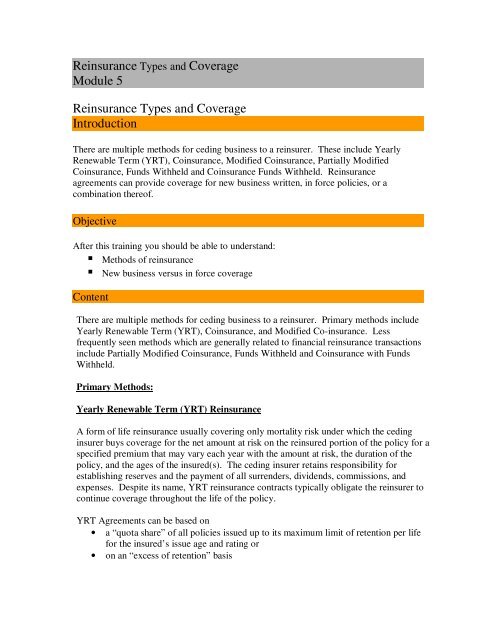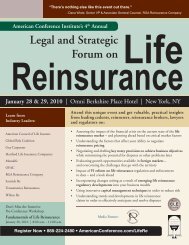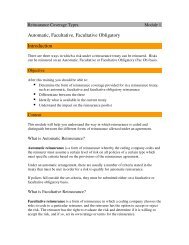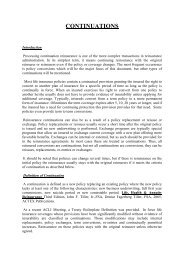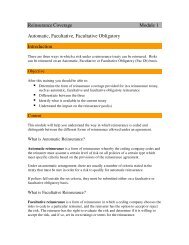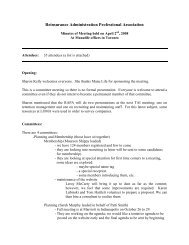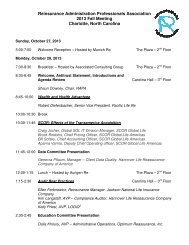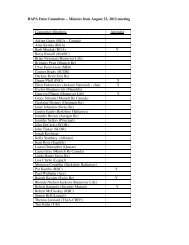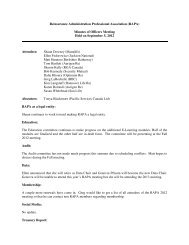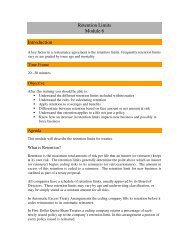Reinsurance Types and Coverage Module 5 Reinsurance Types ...
Reinsurance Types and Coverage Module 5 Reinsurance Types ...
Reinsurance Types and Coverage Module 5 Reinsurance Types ...
You also want an ePaper? Increase the reach of your titles
YUMPU automatically turns print PDFs into web optimized ePapers that Google loves.
<strong>Reinsurance</strong> <strong>Types</strong> <strong>and</strong> <strong>Coverage</strong><br />
<strong>Module</strong> 5<br />
<strong>Reinsurance</strong> <strong>Types</strong> <strong>and</strong> <strong>Coverage</strong><br />
Introduction<br />
There are multiple methods for ceding business to a reinsurer. These include Yearly<br />
Renewable Term (YRT), Coinsurance, Modified Coinsurance, Partially Modified<br />
Coinsurance, Funds Withheld <strong>and</strong> Coinsurance Funds Withheld. <strong>Reinsurance</strong><br />
agreements can provide coverage for new business written, in force policies, or a<br />
combination thereof.<br />
Objective<br />
After this training you should be able to underst<strong>and</strong>:<br />
Methods of reinsurance<br />
New business versus in force coverage<br />
Content<br />
There are multiple methods for ceding business to a reinsurer. Primary methods include<br />
Yearly Renewable Term (YRT), Coinsurance, <strong>and</strong> Modified Co-insurance. Less<br />
frequently seen methods which are generally related to financial reinsurance transactions<br />
include Partially Modified Coinsurance, Funds Withheld <strong>and</strong> Coinsurance with Funds<br />
Withheld.<br />
Primary Methods:<br />
Yearly Renewable Term (YRT) <strong>Reinsurance</strong><br />
A form of life reinsurance usually covering only mortality risk under which the ceding<br />
insurer buys coverage for the net amount at risk on the reinsured portion of the policy for a<br />
specified premium that may vary each year with the amount at risk, the duration of the<br />
policy, <strong>and</strong> the ages of the insured(s). The ceding insurer retains responsibility for<br />
establishing reserves <strong>and</strong> the payment of all surrenders, dividends, commissions, <strong>and</strong><br />
expenses. Despite its name, YRT reinsurance contracts typically obligate the reinsurer to<br />
continue coverage throughout the life of the policy.<br />
YRT Agreements can be based on<br />
• a “quota share” of all policies issued up to its maximum limit of retention per life<br />
for the insured’s issue age <strong>and</strong> rating or<br />
• on an “excess of retention” basis
Treaty provisions will generally indicate the following which is useful for the<br />
administration of the business:<br />
• How the “Reinsured Net Amount at Risk” will be calculated<br />
• How changes in cash/account/terminal reserve value will be allocated<br />
Coinsurance<br />
A method of reinsurance under which the reinsurer receives a proportionate share of the<br />
premiums, sets up a proportionate share of the reserves <strong>and</strong> pays its proportionate share of<br />
the benefits of the reinsured policy. The reinsurer pays the ceding commission <strong>and</strong><br />
expense allowance to the ceding company to represent the reinsurer’s share of the<br />
acquisition <strong>and</strong> maintenance expenses.<br />
Treaty provisions will generally indicate the following which is useful for the<br />
administration of the business:<br />
• How the “Reinsured Net Amount at Risk” will be calculated<br />
• The specific manner <strong>and</strong> timing in which Cash/Account/Terminal Reserve Value<br />
will be measured for the Policy Net Amount at Risk particularly for variable plans<br />
where such amounts may change more frequently.<br />
Modified Coinsurance (Modco)<br />
Indemnity life reinsurance that differs from coinsurance only in that the assets supporting<br />
the reserves are transferred back to the ceding company while the risk remains with the<br />
reinsurer. The ceding company is required to pay interest to replace that which would have<br />
been earned by the reinsurer if it had held the assets corresponding to the reserves in its<br />
own investment portfolio. Used to retain control of investments or to reduce potential<br />
credit risk.<br />
Secondary Methods:<br />
Partially Modified Coinsurance (Part-Co)<br />
This reinsurance method is a combination of coinsurance <strong>and</strong> modified coinsurance. In<br />
most situations, a portion of the initial reserves equal to the initial allowance are held on a<br />
mod-co basis, while remaining reserves are held on a coinsurance basis, eliminating any<br />
initial cash transfer. Also known as Co/Mod-Co.
Funds Withheld<br />
Assets that would normally be paid over to a reinsurer but are withheld by the ceding<br />
company to permit statutory credit for non-admitted reinsurance, to reduce potential credit<br />
risk, or to retain control over investments.<br />
Coinsurance Funds Withheld<br />
A form of modified coinsurance where the initial allowance which is normally paid to the<br />
ceding company is withheld by the reinsurer to reduce the reinsurer’s exposure to the<br />
credit risk of the ceding company.<br />
Example of Treaty Language for <strong>Reinsurance</strong> Basis for Canada<br />
BASIS OF REINSURANCE<br />
<strong>Reinsurance</strong> Basis: < select: ><br />
YRT, or<br />
Coinsurance, or<br />
Other < specify ><br />
Example of Treaty language for <strong>Reinsurance</strong> Basis for the US<br />
This is a [specify basis of reinsurance (e.g., YRT, coinsurance or modified<br />
coinsurance)] agreement for indemnity reinsurance (the “Agreement”) solely between [insert<br />
Ceding Company name] of [insert Ceding Company domicile (e.g., state, province or territory)] (the<br />
“Ceding Company”) <strong>and</strong> [insert Reinsurer name] of [insert Reinsurer domicile] (the “Reinsurer”).<br />
The Ceding Company <strong>and</strong> the Reinsurer may be referred to individually as a “Party” or collectively<br />
as the “Parties”. The performance of the obligations of each Party under this Agreement shall be<br />
rendered solely to the other Party. The acceptance of risks under this Agreement shall create no<br />
right or legal relationship between the Reinsurer <strong>and</strong> the insured, owner or beneficiary of any<br />
insurance policy or other contract of the Ceding Company.<br />
New Business vs. In force Policy <strong>Coverage</strong><br />
<strong>Reinsurance</strong> agreements can provide coverage for new business written or in force policies<br />
(or a combination thereof)<br />
Example of Treaty language for New Business vs. In Force Policy <strong>Coverage</strong> in the US<br />
Policies <strong>and</strong> Risks Reinsured for the 19XX underwriting year:<br />
1. In force Policies <strong>and</strong> Risks Reinsured<br />
On the Effective Date of this Agreement, the amount of reinsurance under this<br />
Agreement will be 100% of the Ceding Company’s net liability on those in force policies<br />
assumed <strong>and</strong> issued by the Ceding Company known as the XYZ POOL. “Net liability”
shall mean the Ceding Company’s liability on policies reinsured hereunder, less<br />
amounts recoverable from other reinsurance.<br />
2. New Policies <strong>and</strong> Risks Reinsured<br />
After the Effective Date of this Agreement, the amount of reinsurance under this<br />
Agreement will be 100% of the Ceding Company’s net liability on policies, assumed <strong>and</strong><br />
issued by the Ceding Company known as the XYZ POOL under the terms of the<br />
agreements between the Ceding Company <strong>and</strong> the XYZ POOL. “Net liability” shall<br />
mean the Ceding Company’s liability on policies reinsured hereunder, less amounts<br />
recoverable from other reinsurance.<br />
Discussion:<br />
Below is a summary of the differences between various options for the basis of<br />
reinsurance.<br />
Basis of<br />
<strong>Reinsurance</strong><br />
Type of Risk Reinsured<br />
Definition of Basis of<br />
<strong>Reinsurance</strong><br />
YRT<br />
Coinsurance<br />
Mortality Risk is transferred to<br />
the Reinsurer<br />
Mortality Risk <strong>and</strong> Reserves<br />
are transferred to the Reinsurer<br />
A form of life reinsurance<br />
usually covering only<br />
mortality risk under which the<br />
ceding insurer buys coverage<br />
for the net amount at risk on<br />
the reinsured portion of the<br />
policy for a specified premium<br />
that may vary each year with<br />
the amount at risk, the<br />
duration of the policy, <strong>and</strong> the<br />
ages of the insured(s). Despite<br />
its name, YRT reinsurance<br />
contracts typically obligate the<br />
reinsurer to continue coverage<br />
throughout the life of the<br />
policy.<br />
A method of reinsurance under<br />
which the reinsurer receives a<br />
proportionate share of the<br />
premiums, sets up a<br />
proportionate share of the<br />
reserves <strong>and</strong> pays its<br />
proportionate share of the<br />
benefits of the reinsured<br />
policy. The reinsurer pays the
ceding commission <strong>and</strong><br />
expense allowance to the<br />
ceding company to represent<br />
the reinsurer’s share of the<br />
acquisition <strong>and</strong> maintenance<br />
expenses.<br />
Modified Coinsurance Mortality Risk transferred to<br />
the Reinsurer <strong>and</strong> Reserves are<br />
Retained by the Ceding<br />
Company<br />
Indemnity life reinsurance that<br />
differs from coinsurance only<br />
in that the assets supporting<br />
the reserves are transferred<br />
back to the ceding company<br />
while the risk remains with the<br />
reinsurer. The ceding company<br />
is required to pay interest to<br />
replace that which would have<br />
been earned by the reinsurer if<br />
it had held the assets<br />
corresponding to the reserves<br />
in its own investment<br />
portfolio. Used to retain<br />
control of investments or to<br />
reduce potential credit risk.<br />
Partially Modified<br />
Coinsurance<br />
Funds Withheld<br />
Initial reserves equal to the<br />
Initial Allowance transferred<br />
on a modified coinsurance<br />
basis; Remaining reserves are<br />
held on a coinsurance basis.<br />
Ceding company holds assets<br />
for investments.<br />
This reinsurance method is a<br />
combination of coinsurance<br />
<strong>and</strong> modified coinsurance. In<br />
most situations, a portion of<br />
the initial reserves equal to the<br />
initial allowance are held on a<br />
mod-co basis, while remaining<br />
reserves are held on a<br />
coinsurance basis, eliminating<br />
any initial cash transfer. Also<br />
known as Co/Mod-Co.<br />
Assets that would normally be<br />
paid over to a reinsurer but are<br />
withheld by the ceding<br />
company to permit statutory<br />
credit for non-admitted<br />
reinsurance, to reduce<br />
potential credit risk, or to<br />
retain control over<br />
investments.
Coinsurance Funds<br />
Withheld<br />
Reinsurer holds assets related<br />
to the initial allowance<br />
A form of modified<br />
coinsurance where the initial<br />
allowance which is normally<br />
paid to the ceding company is<br />
withheld by the reinsurer to<br />
reduce the reinsurer’s<br />
exposure to the credit risk of<br />
the ceding company.
Questions:<br />
1. Indemnity life reinsurance that differs from coinsurance only in that the assets<br />
supporting the reserves are transferred back to the ceding company while the risk<br />
remains with the reinsurer. The ceding company is required to pay interest to<br />
replace that which would have been earned by the reinsurer if it had held the<br />
assets corresponding to the reserves in its own investment portfolio. Used to<br />
retain control of investments or to reduce potential credit risk.<br />
(1) YRT<br />
(2) Coinsurance<br />
(3) Modified Coinsurance<br />
(4) Funds Withheld<br />
2. Which of the following is a primary method of ceding reinsurance to a reinsurer?<br />
a. Funds Withheld<br />
b. Partially Modified Coinsurance<br />
c. Coinsurance<br />
3. A form of life reinsurance usually covering only mortality risk under which the<br />
ceding insurer buys coverage for the net amount at risk on the reinsured portion of<br />
the policy for a specified premium that may vary each year with the amount at<br />
risk, the duration of the policy, <strong>and</strong> the ages of the insured(s).<br />
a. Funds Withheld<br />
b. Partially Modified Coinsurance<br />
c. Coinsurance<br />
d. YRT<br />
NOTES<br />
John E. Tiller, Jr., FSA, MAAA <strong>and</strong> Denise Fagerberg Tiller, FSA, Life, Health, &<br />
Annuity <strong>Reinsurance</strong>, 3 rd ed. (Winsted, CT, ACTEX Publications, Inc., 2005)<br />
American Council of Life Insurers, Life <strong>Reinsurance</strong> Treaty Sourcebook, 2 nd Printing,<br />
2008<br />
Canadian Life <strong>and</strong> Health Insurance Association, Inc., CLHIA <strong>Reinsurance</strong> Treaty<br />
Reference Document, 6 th Printing, 2009


